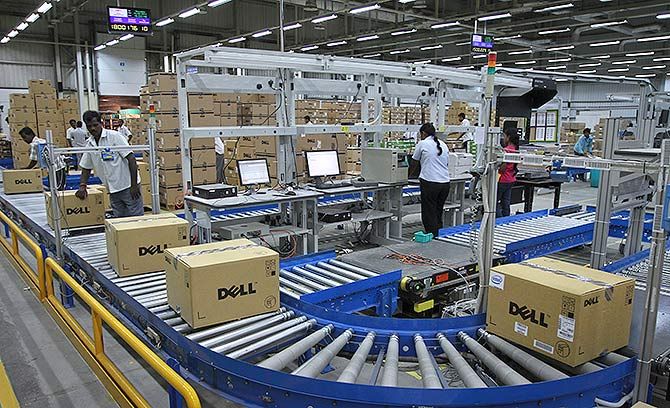'We have the geographic advantage, demographic advantage, we have the necessary technical skills.'
'We just have to get all of these together. Then, we can very well compete.'

India has always been seen as a top destination for IT services, but today, the IT hardware sector also is trying to make a mark on the world map.
With the US-China trade war hotting up, India hopes that many large companies will look at India as an alternate destination. But are we ready to attract them?
"Offsetting the India disability, support has to be given for a short period. It is not that the industry requires support from the government endlessly; it is only for a fixed period of time. This support can be in the form of tax rebates, refunds, etc," George Paul, below, CEO of the IT hardware industry association, MAIT, tells Rediff.com's Shobha Warrier.
From the IT hardware industry's point of view, how do you view the current economic situation? Is it worrying for you?
I would like to say that the electronics industry offers India an opportunity as well as a challenge.
The challenge comes from the fact that we are a large consuming nation and we consume electronics by different sectors of the economy. Be it consumer electronics, be it industrial electronics, be it information technology; consumption is going to happen.
The challenge is, there is very little electronics manufacturing happening in the country. And most of the components that go into the manufacturing industry are imported.
That is the challenge we are facing as we, as a nation, are going to consume electronics and a lot of it is going to be imported, putting the country in a net foreign exchange negative oil deficit scenario.
Oil is also another consumption item which we as a country do not have and we have to import. In the case of electronics also, it is the same situation.
Now, what is the opportunity? The opportunity comes from the fact that we as a nation have the capability to manufacture electronics because we have got the geography, demographics and technical skills. So, with the right policies, we can build electronics manufacturing in the country.
Another opportunity that India has is in PC manufacturing. It is a low hanging fruit for the country with all the major global players already having their manufacturing plants in India primarily addressing the domestic market.
With the right support, we can expand to make them export led manufacturing units.
Now the NPE 2.0 (National Policy on Electronics) very clearly shifts from the old strategy of import substitution to an export-led strategy. If we create an export-led manufacturing strategy, we can have enough value addition in India to have foreign exchange positive.
Many other sectors say as the Indian domestic market is so huge, that itself is enough for growth. But you do feel exports is essential for the electronics sector?
Yes. Another dimension to electronics manufacturing is, it is a highly competitive sector. To sustain, you have to be cost competitive and you should also have the ability to keep innovating.
Unlike other sectors, electronics is a field where continuous innovation is happening and new products with new features are coming out.
Because of this, one of the features in electronics manufacturing is, it has to be essentially done at a global level. That's why it is important to look at an exports-led strategy.
Only then, we will be competitive because demand in India is not so much. If we look at all the sub sectors, we are just 1% to 2% of the global market- maximum, maybe 3% to 4%. And the global market is worth $2 trillion!
Does China dominate the global market?
Yes, today China dominates in terms of manufacturing because manufacturing always goes to the lowest cost destination.
Today, China is the lowest cost destination in manufacturing. So, all the electronics manufacturing goes there; and from China to other South East nations.
When the trade war between the US and China started, there was a talk that large players were looking to relocate from China to India. There is also another point of view that as India is high wage country, large players moving to India will not happen. What is your opinion on this?
The US-China trade war is triggering many large firms building a safety factor for themselves. That is, looking at countries as an alternate to China so that their business is protected. There is uncertainty which is not good for the business.
Yes, when they are looking at an alternate destination, India is one of the options, but not very high on their priority. Other competing economies are also looking at getting these large companies to manufacture from their countries.
South East Asian countries like Malaysia, Vietnam, Indonesia, lead in attracting these companies.
Is high wage a reason?
Studies show that Indian wages are competitive. So, it is not high wage that is causing disadvantage for India.
India has a number of disabilities which are related to infrastructure, ease of doing business, etc.
When you talk about ease of doing business, it has to be a co-ordinated effort by both the central and state governments. It is a fact that there is a lack of a local component ecosystem.
All these add as disabilities that make India a less attractive electronics manufacturing destination.
Do you think it was because India's priority was services and not manufacturing that has led to a situation like this?
No. They are independent. Services built on its own.
In electronics, there is something called ITA 1 listed items under the WTO agreement and each of these products attracts 0% duty.
What China did when WTO was brought in, they signed the agreement for seven years. When they realised that import, customs duty across all nations were going to be 0, manufacturing will move to the lowest cost destination, they used the intervening period to build their manufacturing capabilities. That's how they attracted the global manufacturing to China.
We have to now compete with these economies to be an attractive destination. There are a lot of things the government has done now; for example, the recent announcement on the reduction in corporate tax.
But our assessment is that the overall offset that is needed to overcome the Indian disability is around the tune of 8% which varies from country to country and product to product. So, for a global company to come to come to India to manufacture, they have to overcome this disability.
One sector that has attracted global companies to manufacture in India is the auto sector. Several global companies moved to India after globalisation to manufacture automobiles here.
Is it because we had several auto ancillary units in India while other sectors did not develop in the same way?
One of the things that helped the auto sector was that there was domestic demand. So, they were able to help domestic manufacturing.
In the auto sector, we have been able to put in high tariffs which prevented imports and per se pushed global companies to set up manufacturing units in India.
In electronics, unfortunately, in all the ITA1 products, we don't have that luxury. So, if you are a large manufacturer of electronics products, India's import duty, say, on PCs is 0. So, it is cheaper for them to manufacture in China.
Why should they come to India and set up a factory? What happens is, they will set up a factory in China and bring in the products to India at 0% import duty.
But if you are a car manufacturer, the moment you bring in a car made in China to India, you have to pay 100% or 200% duty. So, they will set up a factory in India as there is reasonable demand in India for automobiles.
That's why electronics manufacturing has not taken up so much in India.
Secondly, when you look at electronics manufacturing vertically, right from the raw materials to components to assembly to products, you will see that the component ecosystem has a very different industry dynamics -- very different from product dynamics.
So, it is very important to promote the component industry also as building materials is 60% of the cost of the product.
The positive aspect is that we have a very proactively engaging ministry. They have taken cognisance of this and they are working towards attracting each of these sub-sectors of electronics to India.

Do you think the idea of electronic cities and Make in India programmes will help India change the scenario in a few years's time?
If they execute these ideas well.
What should the government be doing to execute the ideas well?
One is the very close co-ordination between the Centre and the state.
Executing the policies has to be essentially done at the state level. Today, there is a feeling that exports has to be looked after by the central government and it is not a state subject.
But it is equally a state subject as it generates local employment, subsidiary services, etc. This is one of the key things we have to put in place.
Secondly, offsetting the India disability, support has to be given for a short period. It is not that the industry requires support from the government endlessly; it is only for a fixed period of time. This support can be in the form of tax rebates, refunds, etc.
For example, because there is no component hub in India, a manufacturer in India has to order the components which come by sea and will take at least four weeks. So, you tend to stock inventory for a longer period, say, 30 days.
On the other hand, if you are manufacturing in China, you get the inventory in a day before or two days before production.
What you face in India, a Chinese company does not have to face in China. On top of that, the interest in India is 12% to 14% whereas it is much lower there. That's why manufacturing in India becomes costlier.
What the industry is saying is, we have to offset this disadvantage first along with building a component ecosystem which may take 3 to 4 years. Once the ecosystem comes, this disadvantage is no longer there.
In January this year, it was said that India's exports could go up by 7% to 8%, but it did not happen. On the other hand, we are importing more.
That's because our consumption has gone up. Since we do not have the raw materials, we are importing them more.
Many people are talking about an impending global recession. Do you see it coming?
I am not an expert to comment on this. I would just say that we are so small in the whole game that anything we do can only increase our share in electronics manufacturing.
Had we been a very big electronics manufacturer, a global recession can affect us, but we are not.
When companies are looking for alternate destinations and if we execute well on our disadvantages, we can only grow. So, I would take it positively as an opportunity for India.
Can we ever compete with China or even smaller countries like Vietnam or Indonesia in electronics manufacturing?
We can. Like I said earlier, we have the geographic advantage, demographic advantage, we have the necessary technical skills. We just have to get all of these together. Then, we can very well compete.











 © 2025
© 2025